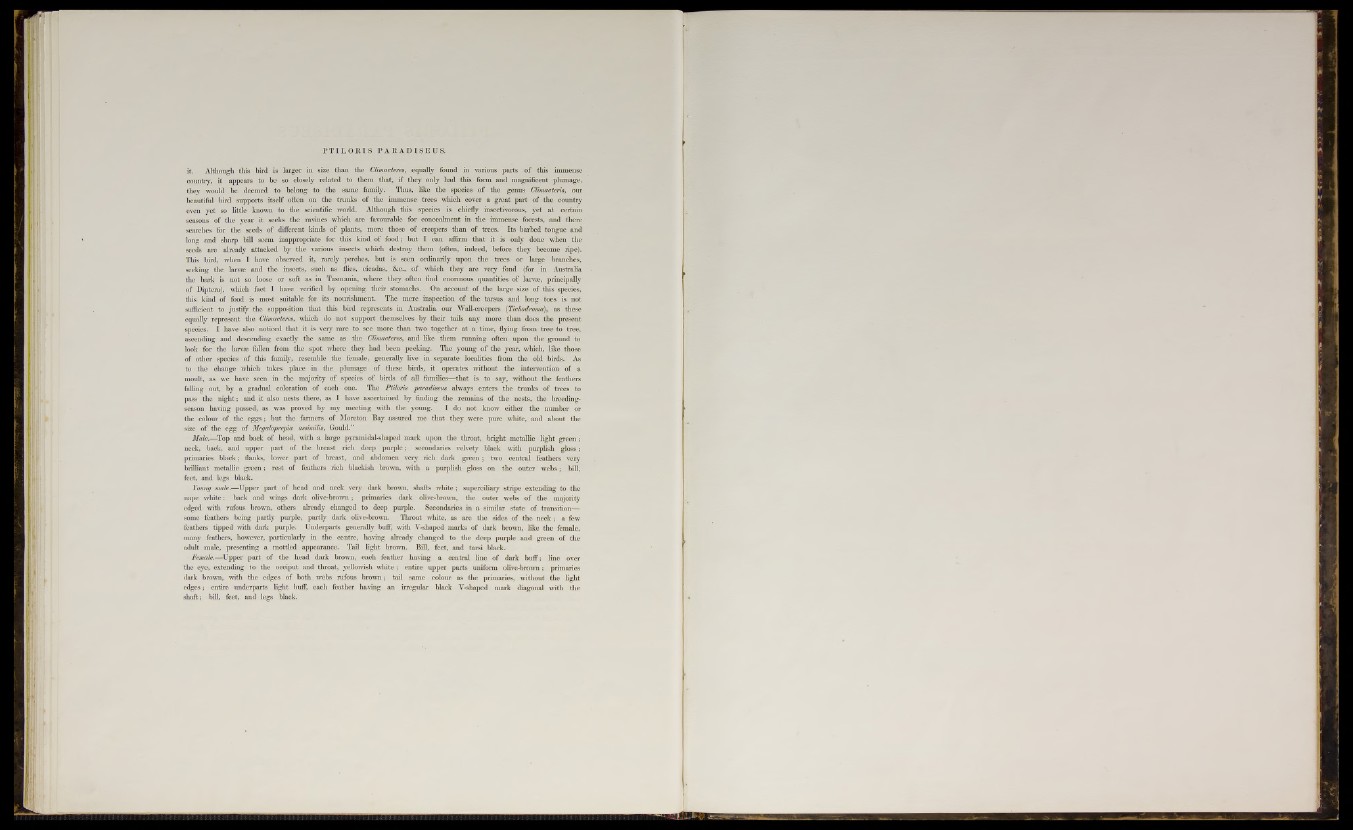
it. Although this bird is larger in size than the Climacterea, equally found in various parts of this immense
country, it appears to be so closely related to them that, if they only had this form and magnificent plumage,
they would be deemed to belong to the same family. Thus, like the species of the genus Climacteris, our
beautiful bird supports itself often on the trunks of the immense trees which cover a great part of the country
even yet so little known to the scientific world. Although this species is chiefly insectivorous, yet at certain
seasons of the year it seeks the ravines which are favourable for concealment in the immense forests, and there
searches for the seeds of different kinds of plants, more those of creepers than of trees. Its barbed tongue and
long and sharp bill seem inappropriate for this kind of food; but I can affirm that it is only done when the
seeds are already attacked by the various insects which destroy them (often, indeed, before they become ripe).
This bird, when I have observed it, rarely perches, but is seen ordinarily upon the trees or large branches,
seeking the larvae and the insects, such as flies, cicadas, &c., of which they are very fond (for in Australia
the bark is not so loose or soft as in Tasmania, where they often find enormous quantities of larvae, principally
of Diptera), which fact I have verified by opening their stomachs. On account of the large size of this species,
this kind of food is most suitable for its nourishment. The mere inspection of the tarsus and long toes is not
sufficient to justify the supposition that this bird represents in Australia our Wall-creepers (TicAoAroma), as these
equally represent the Climacterea, which do not support themselves by their tails any more than does the present
species. I have also noticed that it is very rare to see more than two together at a time, flying from tree to tree,
ascending and descending exactly the same as the Climacterea, and like them running often upon the ground to
look for the larvae fallen from the spot where they had been pecking. The young of the year, which, like those
of other species of this family, resemble the female, generally live in separate localities from the old birds. As
to the change which takes place in the plumage of these birds, it operates without the intervention of a
moult, as we have seen in the majority of species of birds of all families—that is to say, without the feathers
falling out, by a gradual coloration o f each one. The Ptiloria paradiaeua always enters the trunks of trees to
pass the night; and it also nests there, as I have ascertained by finding the remains o f the nests, the breeding-
season having passed, as was proved by my meeting with the young. I do not know either the number or
the colour of the eg g s; but the farmers of Moreton Bay assured me that they were pure white, and about the
size of the egg of Megaloprepia aaaimilia, Gould.”
Males—Top and back of head, with a large pyramidal-shaped mark upon the throat, bright metallic fight green;
neck, back, and upper part of the breast rich deep purple; secondaries velvety black with purplish gloss;
primaries black; flanks, lower part of breast, and abdomen very rich dark green; two central feathers very
brilliant' metallic green; rest of feathers rich blackish brown, with a purplish gloss on the outer webs; bill,
feet, and legs black.
Young male.—Upper part of head and neck very dark brown, shafts white; superciliary stripe extending to the
nape white: back and wings dark olive-brown; primaries dark olive-brown, the outer webs of the majority
edged with rufous brown, others already changed to deep purple. Secondaries in a similar state of transition—
some feathers being partly purple, partly dark olive-brown. Throat white, as are the sides of the neck; a few
feathers tipped with dark purple. Underparts generally buff, with V-shaped marks of dark brown, like the female,
many feathers, however, particularly in the centre, having already changed to the deep purple and green of the
adult male, presenting a mottled appearance. Tail fight brown. Bill, feet, and tarsi black.-
Femate.— Upper part of the head dark brown, each feather having a central line of dark buff; fine over
the eye, extending to the occiput and throat, yellowish white; entire upper parts uniform olive-brown; primaries
dark brown, with the edges of both webs rufous brown; tail same colour as the primaries, without the fight
edges; entire underparts fight buff, each feather having an irregular black V-shaped mark diagonal with the
shaft; bill, feet, and legs black.